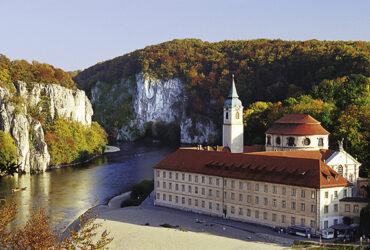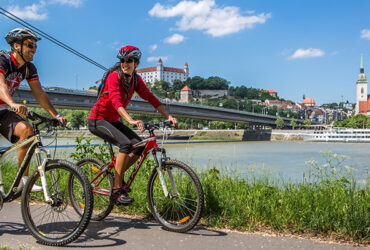Danube Cycle Path I EV6
Discovering the Danube by bike offers an exceptional cycling adventure through the history and cultural diversity of Europe
Cycle along the Danube and enjoy the relaxed atmosphere of Bavaria, with its historic towns, half-timbered houses and wind chimes. Enjoy Austria’s fine wines and monasteries overlooking the Danube. Relax in Budapest’s many thermal baths while visiting this jewel. Fly to Belgrade, a festive and dynamic city, before enjoying the wild landscapes of Romania.
Discover the Danube by bike
The Danube by bike is a popular adventure among cycling enthusiasts. It involves cycling along the Danube cycle path, which follows the course of the Danube River through Europe. This is one of the longest and most beautiful cycle paths in Europe, offering a unique experience for cyclists of all levels.
A bit of history… The Danube River, witness to millennia of history, has played multiple roles, from the earliest civilizations of prehistory to the defensive strategies of the Roman Empire in the Middle Ages. In the modern era, it has become a vital trade route, influenced by world wars and the Cold War in the 20th century. After the fall of the Iron Curtain, the Danube became a symbol of European unity, with cooperation between riparian countries to restore the river’s ecosystem and encourage tourism. Today, it remains an essential part of Europe, with its cycle path offering travellers a unique opportunity to explore its rich history by pedaling along its banks.
The Danube cycle path crosses several countries, including Germany, Austria, Slovakia, Hungary, Croatia, Serbia, Bulgaria and Romania. It offers varied landscapes, historic towns, picturesque castles and a chance to discover the rich cultural diversity of Central and Eastern Europe. The Danube Cycle Route is part of EuroVelo 6, also known as the River Route, which links the Atlantic Ocean to the Black Sea.
The Danube cycle route
The Danube cycle route is divided into several sections, each offering varied landscapes, cultural and historical attractions, as well as relatively flat and safe routes:
- In Germany, the journey starts in Donaueschingen, where the source of the Danube emerges peacefully, then heads to Passau, crossing the mystical Black Forest. Rolling hills and charming villages provide a picturesque introduction to this cycling epic.
- In Austria, the route continues through the Danube valley from Passau to Vienna. Panoramic views extend over verdant vineyards, majestic castles and small towns steeped in history. This section of the route, often flat and well-marked, allows cyclists to take full advantage of the cultural and natural gems along the banks of the Danube.
- The next section crosses Slovakia and Hungary, from majestic Vienna to romantic Budapest, taking cycling explorers through river plains, national parks and enchanting views of the Danube. Between these two iconic cities, the route offers varied terrain, allowing cyclists to immerse themselves in the diversity of Central European landscapes.
- The final stretch from Budapest to the Black Sea adds a wild touch to the adventure. Through Croatia, Serbia, Bulgaria and Romania, the route takes cyclists through unspoilt regions and natural areas of breathtaking beauty. The untamed landscapes offer an immersive experience, testifying to the natural wealth of this part of the continent.
The 10 must-sees on the Danube by bike
Cycling the Danube offers the opportunity to discover a multitude of fascinating sites along its course through Europe. Here are ten must-see sites along the Danube cycle route:
- The Danube Spring in Donaueschingen, Germany: the starting point of the Danube, the spring in Donaueschingen, is an iconic site surrounded by picturesque scenery. Cyclists can start their journey here and explore the charming surroundings of the Black Forest.
- The Confluence of the Danube and Inn Rivers in Passau, Germany: Passau lies at the confluence of the Danube, Inn and Ilz rivers. The city boasts remarkable Baroque architecture, including St. Stephen’s Cathedral and its historic center.
- Melk Palace, Austria: The Melk monastery, perched on a hill overlooking the Danube, is an architectural marvel. Cyclists can visit this Baroque site and enjoy panoramic views over the Danube valley.
- Dürnstein Castle, Austria: this small medieval town is famous for its perched castle, associated with the story of Richard the Lionheart. Cyclists can explore its picturesque streets and taste local wines.
- Danube-Drave National Park, Hungary: this nature reserve offers unspoilt river landscapes, diverse wildlife and winding cycle routes through wetlands.
- The Hungarian Parliament in Budapest, Hungary: in Budapest, cyclists can discover the majestic architecture of the Hungarian Parliament on the banks of the Danube. The night-time illuminations are particularly impressive.
- Golubac Castle, Serbia: on the Serbian banks of the Danube, Golubac Castle is a medieval fortress offering spectacular views of the river.
- Iron Gates, Serbia and Romania: this section of the Danube, also known as the Iron Gorges, offers impressive gorges as the river winds its way through the mountains.
- Danube Delta, Romania: the Danube Delta, a UNESCO World Heritage site, is a unique ecosystem with exceptional flora and fauna. Cyclists can explore the canals and observe the wildlife.
- The Black Sea at Sulina, Romania: the culmination of the Danube Cycle Route, the Black Sea at Sulina offers a peaceful beach and maritime atmosphere, marking the end of a memorable cycling adventure.

 Leisure
Leisure
